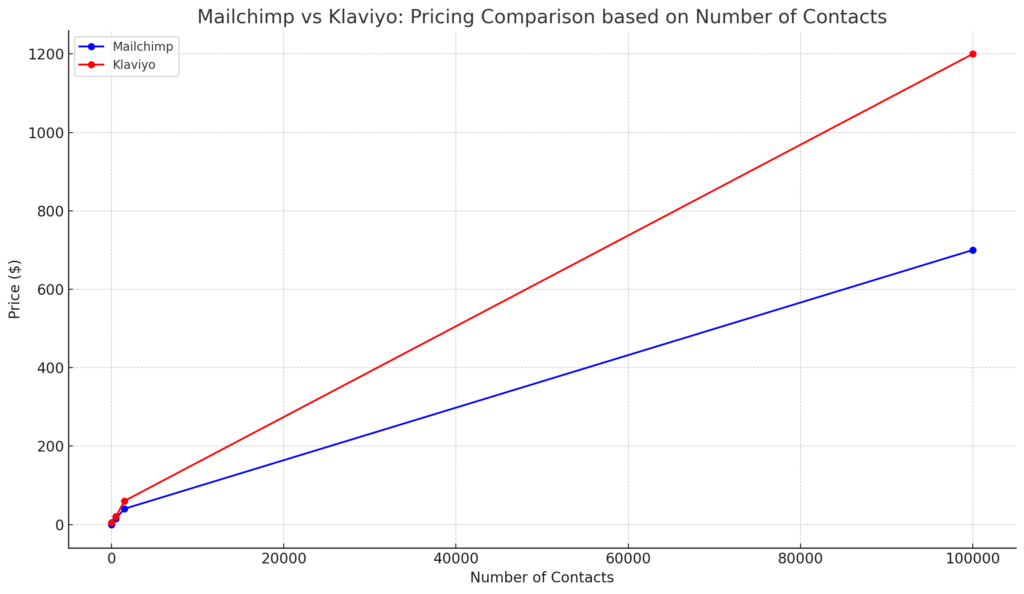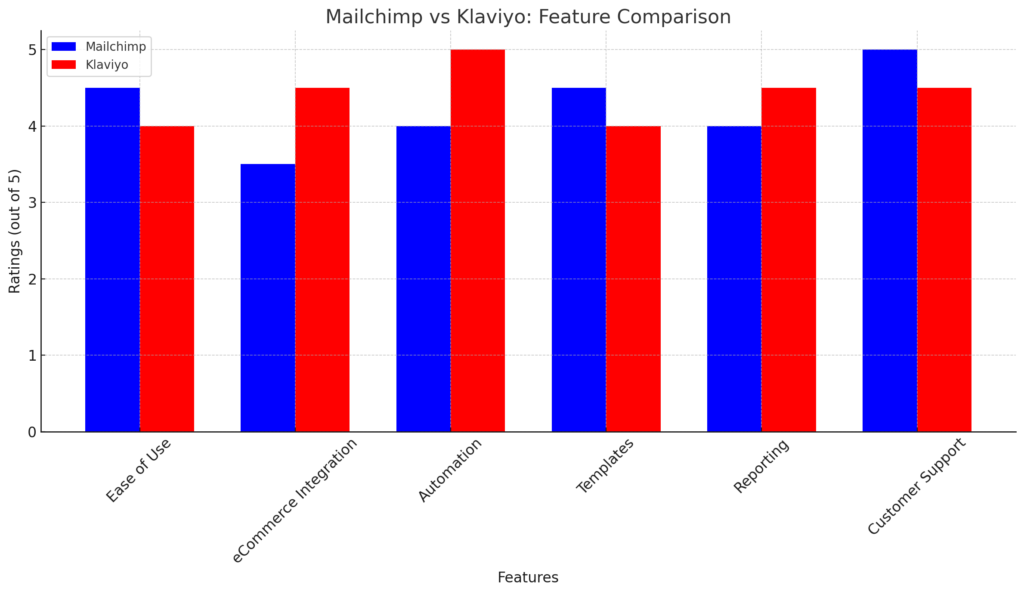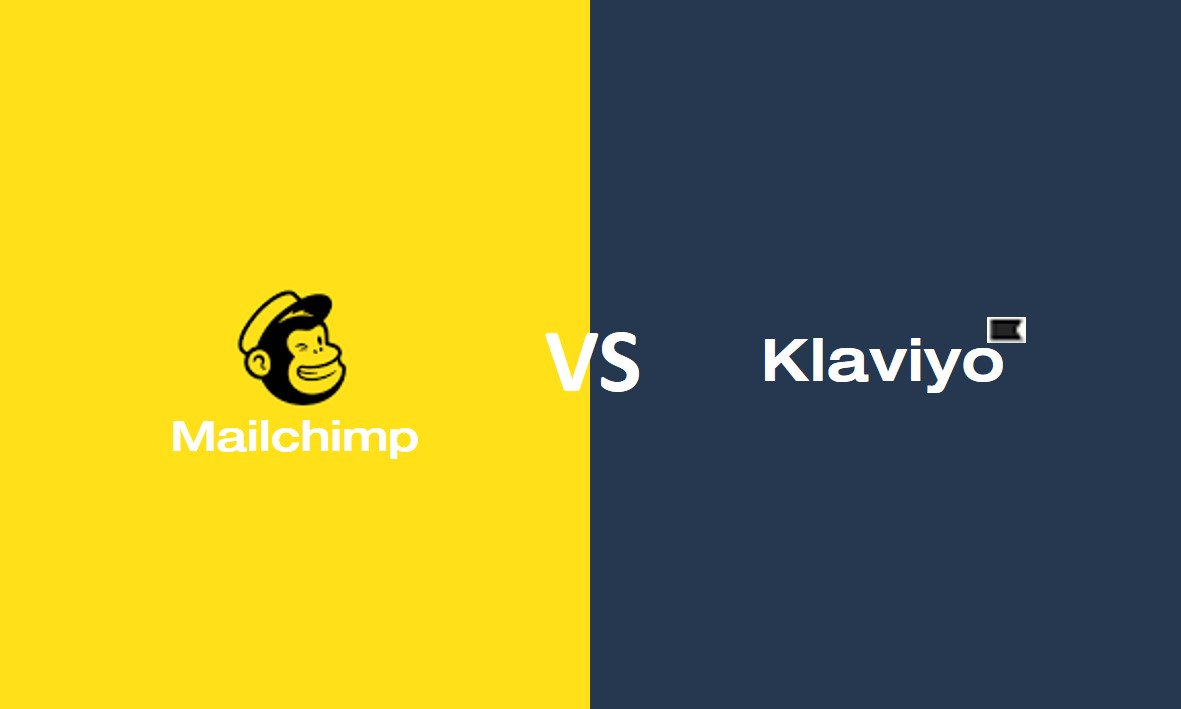This comparison “Mailchimp vs Klaviyo 2023” sheds light on two heavyweights in the industry, dissecting their offerings to help businesses make an informed decision. Both platforms are revered for their robust features, but they cater to slightly different audiences and have distinct advantages. This comprehensive analysis delves into various facets including pricing, platform compatibility, functionalities, ease of learning, suitability for eCommerce, market presence, and user preferences. As you navigate through this comparison, you’ll gain a clearer understanding of which platform aligns well with your business goals, operational needs, and budget considerations. Whether you are a small business owner, a burgeoning eCommerce entity, or a large enterprise, getting a granular insight into Mailchimp and Klaviyo will empower you to harness the full potential of email marketing and customer engagement.
1. Mailchimp vs Klaviyo Pricing
Based on the pricing structures outlined in various sources, it’s apparent that both Mailchimp and Klaviyo offer unique pricing models catering to different user needs and contact volumes. Below is a comparative analysis between Mailchimp and Klaviyo pricing, including an illustrative table to encapsulate the pricing tiers and features at a glance.
When comparing the pricing between Mailchimp and Klaviyo, several factors come into play such as the number of contacts, email sends per month, and the range of features offered. Here’s a breakdown of the pricing for both platforms based on the number of contacts and features:
| Contact Range | Mailchimp Pricing | Klaviyo Pricing |
| 0 – 250 | Free (1,000 sends) | Free (500 sends) |
| 251 – 500 | $26.50* | $20 – $35 |
| 2.5k | Not specified | $60 |
| 10k | Not specified | $150 |
| 25k | Not specified | $400 |
| 100k | $700 | $1,200 |
The price for Mailchimp is based on the Essentials plan which provides 15,000 email sends for 1,500 contacts.
Is Klaviyo cheaper than Mailchimp?
The comparison shows that Klaviyo’s pricing starts off on a competitive note, especially for small contact lists (0 to 500 contacts). For larger contact lists, the price discrepancy widens with Klaviyo being more expensive. For instance, for 100,000 contacts, Klaviyo charges $1,200 per month while Mailchimp charges $700 for its standard plan.
How many free emails can I send with Klaviyo?
Klaviyo offers a free plan for up to 250 contacts, allowing users to send up to 500 emails per month. In contrast, Mailchimp’s free plan permits 1,000 email sends per month for up to 500 contacts.
This pricing analysis provides a glimpse into the financial commitment required when opting for either Mailchimp or Klaviyo. While Klaviyo tends to be pricier as the contact list grows, its pricing is competitive for smaller lists. On the other hand, Mailchimp provides a more generous free plan in terms of email sends. The choice between Mailchimp and Klaviyo may further hinge on the specific features and functionalities each platform provides, which will be explored in the subsequent sections of the article.

2. Platform Compatibility: What platforms does Klaviyo work with?
In today’s digital ecosystem, having a marketing platform that seamlessly integrates with other essential tools is a prerequisite for efficient and effective operations. Klaviyo, being a robust marketing automation platform, offers a wide range of integrations, bridging the gap between your marketing efforts and other crucial business operations. This section delves into the platforms Klaviyo integrates with and explores the feasibility of using Klaviyo independently of Shopify.
What platforms does Klaviyo work with?
Klaviyo provides extensive integration capabilities, allowing businesses to connect with various platforms they already use. Here are some of the integration categories Klaviyo supports:
1. Payment Platforms: Integration with payment processing platforms ensures smooth transaction processing and data synchronization.
2. Cart and Order Management: These integrations facilitate streamlined management of orders and shopping carts, enhancing the user experience.
3. Support Tickets: By integrating with support ticket platforms, Klaviyo helps businesses provide timely customer support.
4. Subscriptions: Subscription management is simplified through Klaviyo’s integrations, aiding in subscriber retention.
5. Shipping: Klaviyo integrates with shipping platforms to ensure timely delivery updates and tracking.
6. Surveys: Collect valuable feedback from customers by integrating survey platforms with Klaviyo.
7. Referrals and Reviews: Foster a community of brand advocates by managing referrals and reviews through Klaviyo’s integrations.
Additionally, Klaviyo has recently announced new integrations with platforms like Square Online and commerce tools, expanding its reach in the ecommerce domain. Klaviyo boasts over 300 integrations, covering a plethora of ecommerce platforms, cart and order management systems, subscription services, and much more.
Can you use Klaviyo without Shopify?
Yes, Klaviyo is not exclusively tied to Shopify and can be used with various other platforms. If your ecommerce platform does not have a pre-built Klaviyo integration, you can still integrate it using Klaviyo’s APIs. This flexibility ensures that even if you’ve built a custom ecommerce solution or use an ecommerce platform that isn’t directly supported by Klaviyo, you can leverage Klaviyo’s marketing automation capabilities.
This comprehensive integration capacity makes Klaviyo a versatile choice for businesses operating on different platforms, ensuring they can harness the power of Klaviyo’s marketing automation irrespective of their existing tech stack.
3. Functionalities: What are the advantages of Klaviyo over Mailchimp?
When it comes to the functionalities, Klaviyo holds a distinctive edge over Mailchimp in several aspects, particularly catering to the ecommerce sector. Below are some notable advantages of Klaviyo over Mailchimp:
1. Advanced Segmentation: Klaviyo provides granular audience segmentation, enabling businesses to target their audiences based on a plethora of criteria, thereby delivering more personalized and relevant emails.
2. Ecommerce Integrations: Klaviyo is known for its seamless ecommerce integrations, aligning well with platforms like Shopify, and thus is a preferred choice for ecommerce businesses.
3. Automation Capabilities: Klaviyo’s automation features are robust, allowing for creation and management of targeted email campaigns, automations, and personalization, which are crucial for effective email marketing.
4. Superior Customer Support: Klaviyo tends to have better customer support, aiding users through any hurdles they face while using the platform.
5. Reporting and Analytics: Klaviyo provides detailed reporting and analytics, aiding businesses in measuring the effectiveness of their email marketing campaigns.
Here’s a comparative table illustrating the key advantages of Klaviyo over Mailchimp:
| Feature | Klaviyo | Mailchimp |
| Segmentation | Advanced, granular segmentation | Basic segmentation |
| Ecommerce Integrations | Extensive | Limited |
| Automation | Robust automation and personalization | Basic automation |
| Customer Support | Superior | Standard |
| Reporting and Analytics | Detailed reporting and analytics | Basic reporting and analytics |
Does Klaviyo work as CRM?
Klaviyo is primarily known as a marketing automation platform. While it houses a rich reservoir of customer data and enables segmentation and targeted communication, it doesn’t offer a full suite of Customer Relationship Management (CRM) features such as lead management, sales automation, or customer service functionalities that are typically found in dedicated CRM systems.
However, Klaviyo’s capabilities in managing customer data and facilitating personalized communication make it a valuable tool for marketing teams to complement their CRM initiatives. It’s advisable for businesses to use Klaviyo alongside a dedicated CRM system to get the best of both worlds: robust marketing automation and comprehensive customer relationship management.
This section highlights Klaviyo’s strengths in functionality, especially when pitted against Mailchimp, and sheds light on its scope in CRM functionalities.

4. Is Klaviyo easy to learn?
The ease of learning and using Klaviyo is subject to the individual’s prior experience with marketing platforms, as well as the complexity of the tasks they wish to accomplish. Here are some insights gathered from various sources regarding the ease of learning Klaviyo:
1. Ease of Setup: Klaviyo is designed to seamlessly integrate with ecommerce platforms, which makes the initial setup relatively straightforward, especially for those who have some technical background.
2. Learning Curve: Klaviyo, with its extensive capabilities, presents a steeper learning curve. Mastering Klaviyo is likened to mastering a complex instrument; it takes time to become proficient. The platform’s high level of customizability is a double-edged sword; while it allows for tailored marketing solutions, it may pose challenges for beginners.
3. User-Friendly Interface: Some users find Klaviyo to be user-friendly, with a smooth marketing automation setup and easy implementation. The interface is described as intuitive for configuring email sequences, automation, and website pop-ups.
4. Support and Resources: Klaviyo provides various resources for learning and support. It’s advisable to leverage these resources to overcome the learning curve and make the most out of the platform.
5. Community Discussions: There are community forums and discussions that can be a good source of learning and support for new users.
The mixed reviews indicate that while Klaviyo is user-friendly and easy to set up, mastering its extensive capabilities may require a time investment. Individuals with prior experience in digital marketing or using marketing automation platforms may find the learning curve less steep compared to those who are new to the domain.
Individual experiences may vary, and it’s recommended to make use of the available resources, tutorials, and community support to get accustomed to Klaviyo and make the most out of its features.
5. Is Klaviyo best for eCommerce?
Klaviyo is widely recognized for its prowess in serving eCommerce businesses, offering features like Shopify-triggered workflows and predictive AI product recommendations that cater specifically to the needs of online retailers. It has cemented itself as the go-to Email Service Provider (ESP) for eCommerce, particularly for Shopify store owners, due to its top-notch features tailored for this sector. Klaviyo provides a comprehensive suite of marketing tools that enable eCommerce businesses to scale their campaigns effectively, making it a highly favored choice in this domain.
The market presence of Klaviyo and Mailchimp can be gauged by examining their customer base and the market share they hold in the Online Marketing industry. As of 2023, Mailchimp has a larger market share than Klaviyo. Specifically, Mailchimp holds a 42.02% market share, while Klaviyo holds a 6.61% market share in the Online Marketing industry, indicating a significant difference in their market presence. The customer base also reflects this disparity, with Mailchimp boasting 662,991 customers to Klaviyo’s 104,330 customers in this sector.
Table: Market Share and Customer Base (2023)
| Metric | Mailchimp | Klaviyo |
| Market Share | 42.02% | 6.61% |
| Customer Base | 662,991 | 104,330 |
Brands Using Klaviyo
Klaviyo has garnered trust from over 50,000 brands, with a few notable names being Chubbies, Living Proof, and Hint. Some other brands leveraging Klaviyo for their email marketing needs include:
– BrüMate: A drinkware brand that utilizes Klaviyo for email marketing, focusing heavily on their email list, which comprises around 250,000 subscribers and contributes to about 20% of their monthly revenue stream.
– ChipMonk Baking: A food startup that uses Klaviyo for regular email blasts to subscribers and automated flow emails based on user behavior on their website. Their email campaigns typically have open rates over 15%.
– Milla Rose: A florist that uses Klaviyo for email marketing due to its good integration with Shopify and pre-set flow setups which only require minor tweaks before being published.
These brands come from various sectors within the eCommerce industry, indicating Klaviyo’s versatility and effectiveness in catering to different types of eCommerce businesses.
The above data and examples illustrate that while Klaviyo has a smaller market share compared to Mailchimp, it has carved out a solid and growing presence in the eCommerce space, backed by endorsements from a wide range of brands.
7. User Preferences: Why do people use Klaviyo?
People opt for Klaviyo due to its ability to centralize and utilize customer data effectively, which aids in automating personalized email and SMS communications. Klaviyo’s robust feature set includes email automation flows and AI-based product recommendations, catering particularly to eCommerce businesses and aiding in driving revenue through customer engagement. The platform is renowned for its intuitive design, ease in customizing emails, a wide range of templates, and good integration with eCommerce platforms like Big Commerce and Shopify, which facilitates sound marketing decisions.
Moreover, users appreciate Klaviyo for its seamless creation, scheduling, and management of email campaigns or weekly newsletters, and its ability to easily craft and automate SMS and email campaigns to market products. The platform’s capabilities in sending mass emails and SMS, collecting customer feedback, and aiding in customer acquisitions are valued by its users. Furthermore, Klaviyo is lauded for its effectiveness in managing email lists and driving customer engagement, which in turn drives recurring revenue for businesses.
Table: Why People Use Klaviyo
| Aspect | Description |
| Data Centralization | Effectively centralizes and utilizes customer data for personalized marketing. |
| eCommerce Optimization | Tailored features for eCommerce, aiding in customer engagement and revenue generation. |
| Email & SMS Automation | Seamless creation, scheduling, and automation of email and SMS campaigns. |
| Integration | Good integration with eCommerce platforms for sound marketing decisions. |
What are the drawbacks of Klaviyo?
Despite its strengths, Klaviyo is not without drawbacks. The platform can be quite intimidating for less experienced users due to its in-depth features. The pricing model is another point of contention; users need to manually deactivate list members, which can be cumbersome, and some find the costs for email and SMS marketing plans to be on the higher side. Furthermore, there have been mentions of unprofessional customer support, which can negatively impact the user experience.
Table: Drawbacks of Klaviyo
| Drawback | Description |
| Learning Curve | Can be intimidating for less experienced users. |
| Pricing Model | Requires manual deactivation of list members; high costs for some plans. |
| Customer Support | Instances of unprofessionalism reported by users. |
These insights reflect a mix of user preferences, showcasing why Klaviyo is a favored choice for many, while also acknowledging areas where the platform could improve. By understanding both the advantages and the drawbacks, prospective users can make an informed decision on whether Klaviyo aligns with their marketing needs and budget considerations.




